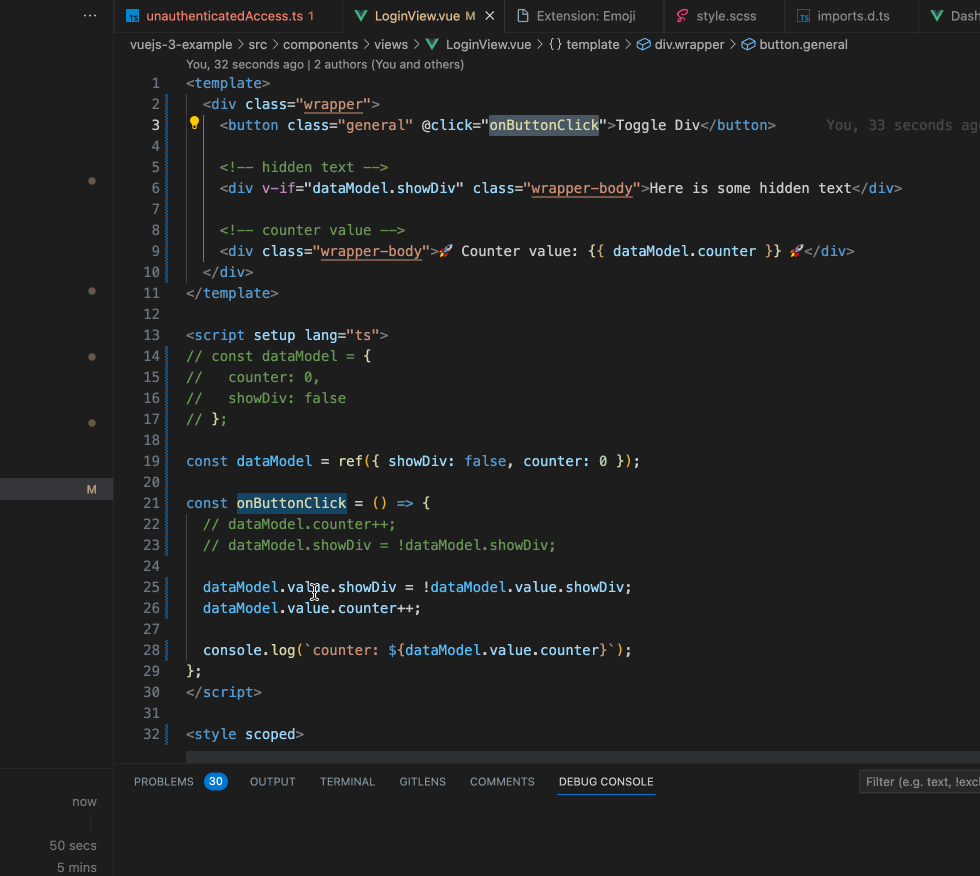Vue.js is a popular JavaScript framework that provides developers with various tools to create dynamic and reactive web applications.
One of the key features of Vue is its reactivity system, which enables the framework to efficiently update the view when the state changes. In this blog post, you’ll learn the different types of reactive objects, such as ref and reactive, when to use which, and ones that you maybe haven’t heard of like shallowRef and shallowReactive.
What is Ref?
The ref function is used to create a reactive reference to a single value. This value can be a primitive type like a string or number or an object or array.
To access the value of the ref function, you need to use the .value keyword. By using reactive references, such as ref, Vue under the hood will track any changes made to this instance and update the DOM if the value of the variable changes. An example can be seen in the following code.
<template>
<div>
<button @click="onButtonClick">Toggle Div</button>
<!-- hidden text -->
<div v-if="dataModel.showDiv">Here is some hidden text</div>
<!-- counter value -->
<div>🚀 Counter value: {{ dataModel.counter }} 🚀</div>
</div>
</template>
<script setup lang="ts">
const dataModel = ref({ showDiv: false, counter: 0 });
const onButtonClick = () => {
dataModel.value.showDiv = !dataModel.value.showDiv;
dataModel.value.counter++;
console.log(`counter: ${dataModel.counter}`);
};
</script>Every time you click on the button, a div will be revealed/hidden, and a counter will be incremented. Such a real-world example, I know! In order to tell Vue that you want to make the dataModel reactive, you need to use ref otherwise, the DOM will receive no updates.
What if I don’t use Ref?
Coming back to the above example, you may ask, what would happen if I use simple object instead of the ref function? Let’s try to execute the following code:
<template>
<div>
<button @click="onButtonClick">Toggle Div</button>
<!-- hidden text -->
<div v-if="dataModel.showDiv">Here is some hidden text</div>
<!-- counter value -->
<div>🚀 Counter value: {{ dataModel.counter }} 🚀</div>
</div>
</template>
<script setup lang="ts">
const dataModel = {
counter: 0,
showDiv: false
};
const onButtonClick = () => {
dataModel.counter++;
dataModel.showDiv = !dataModel.showDiv;
console.log(`counter: ${dataModel.counter}`);
};
</script>The only change is replacing the ref function with a normal object. However, with the simple change, the whole DOM will stop being reactive, so any change made to the object will not be reflected in the HTML.

Reactive
The reactive function creates a reactive object that can hold any number of properties. However, reactive can't hold primitives. You will receive the following error:

When the properties of this object are updated, the view is updated automatically. This powerful feature makes it easy to create complex reactive applications. Here’s an example of how to use reactive:
<template>
<div>
<button @click="onButtonClick">Toggle Div</button>
<!-- hidden text -->
<div v-if="dataModel.showDiv">Here is some hidden text</div>
<!-- counter value -->
<div>🚀 Counter value: {{ dataModel.counter }} 🚀</div>
</div>
</template>
<script setup lang="ts">
const dataModel = reactive({
counter: 0,
showDiv: false
});
const onButtonClick = () => {
dataModel.counter++;
dataModel.showDiv = !dataModel.showDiv;
console.log(`counter: ${dataModel.counter}`);
};
</script>When working with the reactive function, always access the object by its keys. When you try to change the reactive variable reference, the reactivity will break. In the following code, you can see an example of a broken reactivity
let dataModel = reactive({
counter: 0
});
const onButtonClick = () => {
dataModel = reactive({
counter: dataModel.counter + 1
});
};Should I use Ref or Reactive?
You will find in the documentation that ref is used mainly for primitives but also can be used for objects while reactive is only used for objects.
At first glance, the main difference is just using the .value keyword when accessing the value of the ref property. However, another thing is with the implementation. Taking a look at the ref implementation from Github, you can see the following code:
class RefImpl<T> {
private _value: T
private _rawValue: T
public dep?: Dep = undefined
public readonly __v_isRef = true
constructor(value: T, public readonly __v_isShallow: boolean) {
this._rawValue = __v_isShallow ? value : toRaw(value)
this._value = __v_isShallow ? value : toReactive(value)
}
get value() {
trackRefValue(this)
return this._value
}
set value(newVal) {
const useDirectValue =
this.__v_isShallow || isShallow(newVal) || isReadonly(newVal)
newVal = useDirectValue ? newVal : toRaw(newVal)
if (hasChanged(newVal, this._rawValue)) {
this._rawValue = newVal
this._value = useDirectValue ? newVal : toReactive(newVal)
triggerRefValue(this, newVal)
}
}
}Every time you create a reactive variable by ref, passing an object into its constructor, on line 10, it is treated as you would use the reactive keyword. So should I use ref or reactive for objects?
This is a personal preference, but I use ref almost all the time. It may be tedious to always write the .value to access the ref’s value; however, the Vue team is aware of the problem, and there is an open RFC - Reactivity Transform, that aims to solve this issue.
The reactivity transform is not yet part of the official Vue.js package, however, you can already use it with the following configuration.
// vite.config.ts
import vue from "@vitejs/plugin-vue";
import { defineConfig } from "vite";
export default defineConfig({
plugins: [
vue({
// used to enable tranctivity transform
reactivityTransform: true
}),
]
});And use reactivity transformation in the following way
<template>
...
</template>
<script setup lang="ts">
const dataModel1 = $ref({
counter: 0
});
const dataModel2 = ref({
counter: 0
});
const onButtonClick = () => {
dataModel1.counter++;
dataModel2.value.counter++;
};
</script>Reactivity API
Vue provides additional functions to achieve reactivity with high performance in your application. You can learn more about them on the official documentation, however, it is worth highlighting two of them, which are shallowRef and shallowReactive.
ShallowRef
The shallowRef function is similar to ref, but with one key difference: the changes made to its properties will trigger a change only if you change the memory reference. It is used for performance optimizations of large data structures or integration with external state management systems. Looking at the official documents, the Vue community provides us with the following example.
const state = shallowRef({ count: 1 })
// does NOT trigger change
state.value.count = 2
// does trigger change
state.value = { count: 2 }Examples of when you should prefer using shallowRef instead of ref can be working with chart data, where you want to exclude basic reactivity for application optimization but still have reactivity if you change the data reference. Another example can be working with dynamic components, such as the following example.
<template>
<section>
<!-- display buttons for dynamic component -->
<button @click="dynamicComponent = Comp1">Comp1</button>
<button @click="dynamicComponent = Comp2">Comp2</button>
<!-- dynamic component -->
<keep-alive>
<component :is="dynamicComponent" />
</keep-alive>
</section>
</template>
<script setup lang="ts">
import Comp1 from "../shared/Comp1.vue";
import Comp2 from "../shared/Comp2.vue";
const dynamicComponent = shallowRef();
</script>ShallowReactive
The shallowReactive function is similar to reactive, without nested objects, because changes made to the properties of nested objects or arrays will not trigger the update of the view. One may consider using it to get minor performance, instructing Vue that nested properties don’t have to be reactive. However, even the Vue.js team gives a warning of its usage.
Shallow data structures should only be used for root level state in a component. Avoid nesting it inside a deep reactive object as it creates a tree with inconsistent reactivity behavior which can be difficult to understand and debug.
Here is an example of using shallowReactive
<template>
<div>
<button @click="onButtonClick">Toggle Div</button>
<!-- hidden text -->
<div v-if="dataModel.showDiv.value">Some hidden text</div>
<!-- counter value -->
<div>🚀 Counter value: {{ dataModel.counter }} 🚀</div>
</div>
</template>
<script setup lang="ts">
const dataModel = shallowReactive({
counter: 0,
showDiv: {
value: false
}
});
const onButtonClick = () => {
// trigger reactivity
dataModel.counter++;
// doesn't trigger reactivity
dataModel.showDiv.value = !dataModel.showDiv.value;
console.log(`counter: ${dataModel.counter}`);
};
</script>Summary
In this blog post, you learned the differences between ref and reactive in Vue.js. In conclusion, there are small minor differences between both of them. However, when it comes to production applications, you can use either of them.
For more information, check out our training program or book your free Vue.js consulting call to discuss your project with an expert.
Do you have ideas about improving Vue.js performance?
We’d love to hear them! Join our Community Discord and drop by the #Angular channel to talk with our Vue development experts. 👋
Next Post





